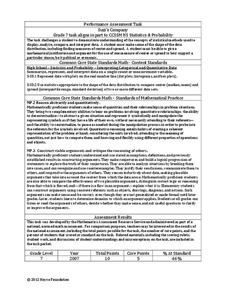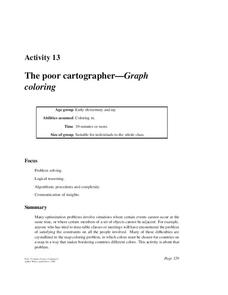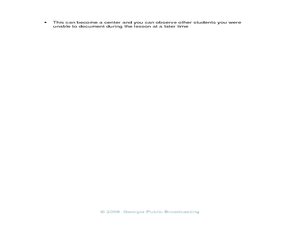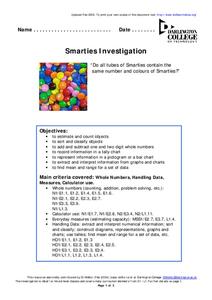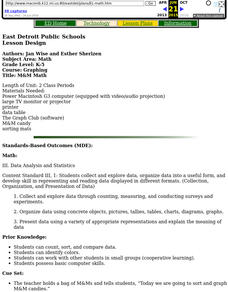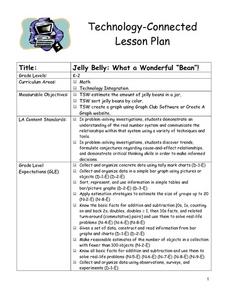Noyce Foundation
Granny’s Balloon Trip
Take flight with a fun activity focused on graphing data on a coordinate plane. As learners study the data for Granny's hot-air balloon trip, including the time of day and the distance of the balloon from the ground, they practice...
Inside Mathematics
Conference Tables
Pupils analyze a pattern of conference tables to determine the number of tables needed and the number of people that can be seated for a given size. Individuals develop general formulas for the two growing number patterns and...
Public Schools of North Carolina
Math Stars: A Problem-Solving Newsletter Grade 1
Keep the skills of your young mathematicians up-to-date with this series of newsletter worksheets. Offering a wide array of basic arithmetic, geometry, and problem solving exercises, this resource is a great way to develop the...
Inside Mathematics
Suzi's Company
The mean might not always be the best representation of the average. The assessment task has individuals determine the measures of center for the salaries of a company. They determine which of the three would be the best representation...
National Nanotechnology Infrastructure Network
Is Measuring an Art or a Science?
Not only do future engineers learn the difference between accuracy and precision, they also get some hands-on experience using different measuring tools.
Public Schools of North Carolina
Math Stars: A Problem-Solving Newsletter Grade 4
Fresh off the press, these math newsletters will challenge the problem solving skills of your young mathematicians. With an incredibly wide variety of questions covering the topics of arithmetic and geometry, these unique...
Virginia Department of Education
Organizing Topic: Probability
The probability is high learning will occur! A well-designed unit introduces learners to the concepts of independent, dependent, and mutually exclusive events. Using Venn diagrams, the lessons ask learners to analyze many different...
Computer Science Unplugged
The Poor Cartographer—Graph Coloring
Color the town red. Demonstrate the concept of graph theory with a task that involves determining the least number of colors needed to color a map so that neighboring countries are not represented by the same color. Pupils...
Cornell University
Glued into Science—Classifying Polymers
Explore the unique characteristics of polymers. A complete lesson begins with a presentation introducing polymers. Following the presentation, young scientists develop a laboratory plan for creating substances using polymers. They...
Curated OER
Sorting Gourds
Students discover different types of gourds. In this plant comparison lesson, students compare and contrast several types of gourds based on shape, color and texture. Students observe a video clip based on sorting gourds.
Curated OER
Race to 50/100
Second graders practice utilizing multiple tens frames and dice to race to fifty or one hundred. They calculate tens and ones to find out how many counters they have on their grid and how many more they need to get to fifty or one...
Curated OER
Origins
Students trace the history of the invention of everyday objects. They brainstorm a list of curios objects and watch a video clip showing an example of tracing the origins of squeezable ketchup. In small groups, they choose an item to...
Curated OER
Place Value
First graders practice place value by completing problems that allow them to group 10 items together to create groups of 10 and see what is left over. In this place value lesson plan, 1st graders use cups to put 10 items in them, and...
Curated OER
Smarties Investigation
In this math worksheet, learners participate in an investigation of Smarties candy. For example, students estimate how many candies they have in each color, count the actual number, and record the information in a tally chart.
Curated OER
Buggy Patterns
First graders discuss the definition of patterns, and sing the song, Going Buggy, identifying patterns in the song. They create original patterns using bug counters and insect stickers.
Curated OER
Inventors and Inventions 1
Learners research how Velcro and sticky notes were invented. In this research report, students use the Internet to learn about how to common inventions came to be. Learners write a report about their findings.
Curated OER
Shapes And Colors
Students distinguish between circles, squares, and rectangles and various colors in which they utilize the KidPix program on the computer to create them. They alternate; allowing each student to have a turn constructing and coloring in...
Curated OER
M&M Math
Learners sort a bag of M&M candies according to color using a sorting mat. They count M&M candies. They compare the number to their prediction then students create tally charts.
Curated OER
Arrays And Factors
Students participate in a lesson that is concerned with the concepts of arrays and factors. They use a Hershey bar and divide it into segments in order to simulate the arrays. Then students construct other arrays from the leftover pieces.
Curated OER
How Does Light Move?
Second graders investigate how light passes through objects, is blocked, bounces off of things, and bends. They discuss how light moves in different ways, and with a partner walk around the room with a flashlight, shining the light on...
Curated OER
"Julie of the Wolves"
Fifth graders research life in Alaska and compare life there to their lives in this lesson. They read "Julie of the Wolves." They research through the novel and other reference books facts about the Alaskan climate and geography. They...
Curated OER
Related Number Pairs
Third graders use tables to organize and display related pairs of numbers, such as the relationship of the number of insects to the total number of legs. They generate a table of related number pairs based on a real-life situation,...
Curated OER
Math All Around Us!
Learners find math concepts in every day items. For this math concept lesson, students take ten photographs of things they find interesting. They analyze the photographs to find hidden math concepts such as counting, lines, angles,...
Curated OER
Jelly Belly: What a Wonderful "Bean"!
Students explore how jelly beans are produced. They discuss the origins of the jelly bean and view a video about how jelly beans are prepared, tested, shaped, finished, and shipped and estimate the amount of jelly beans in a jar and sort...



